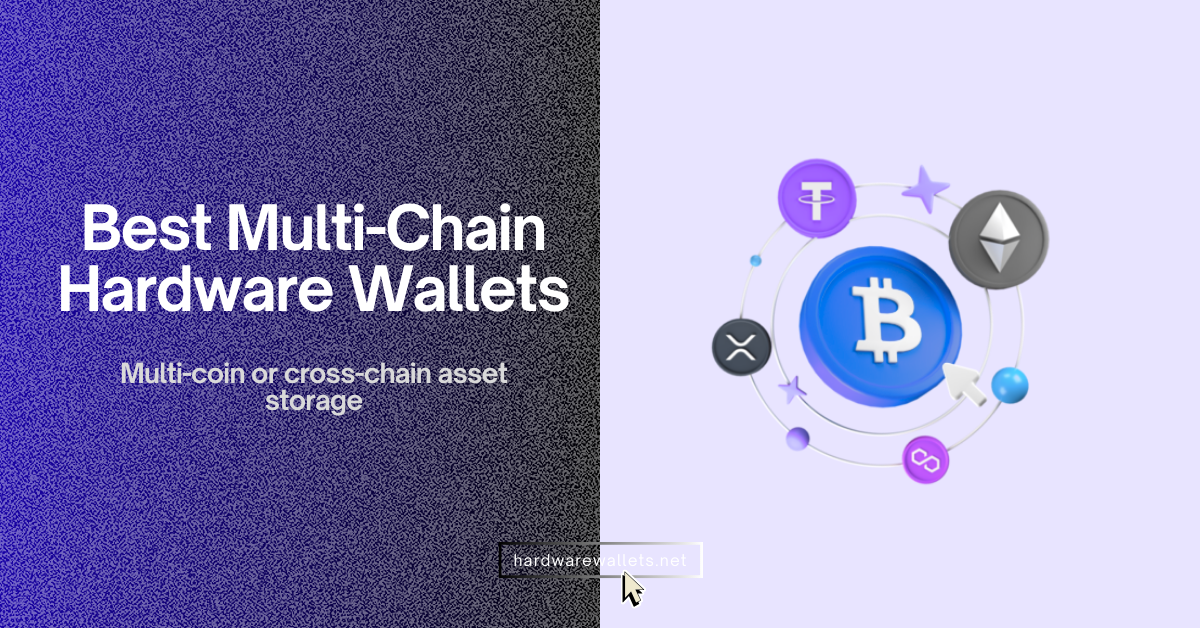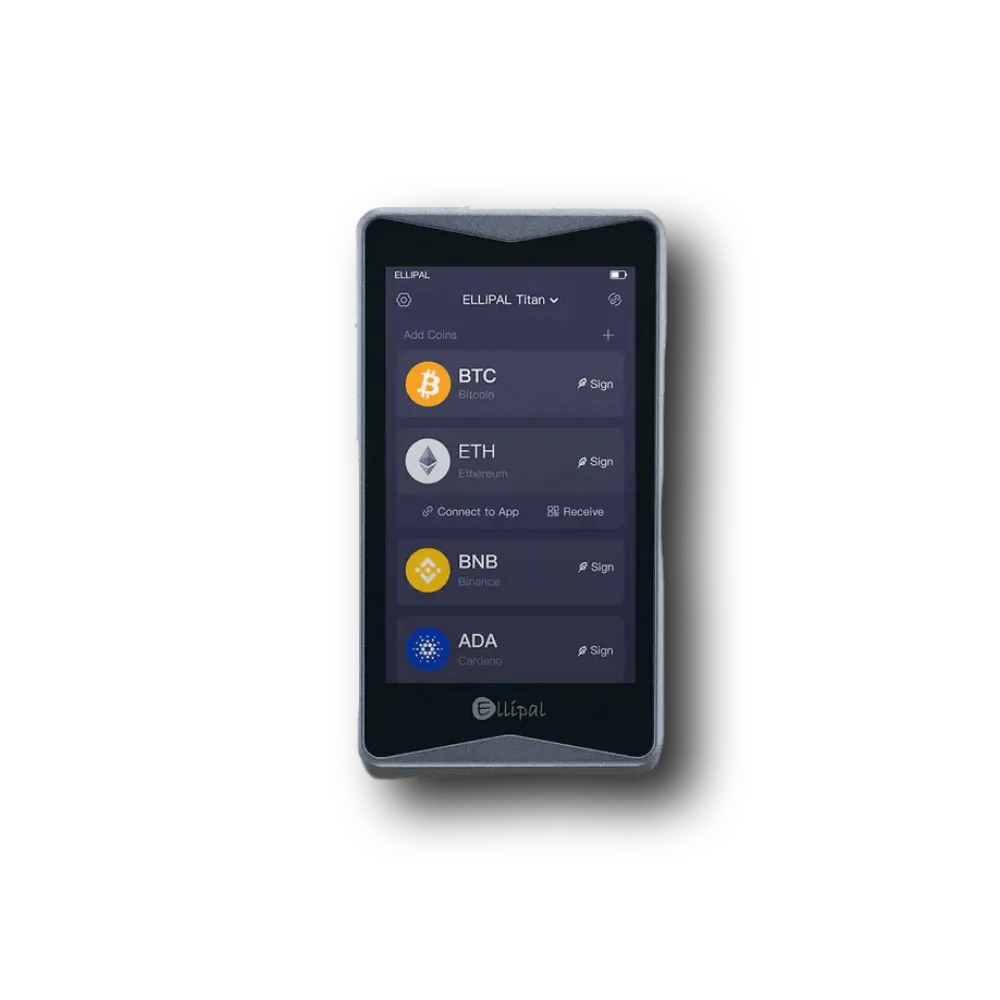Quick Sum Up: The best multi-coin hardware wallets for multi-chain assets are Ledger Nano X, ELLIPAL Titan 2.0, Trezor Safe 5, Ledger Flex, Keystone 3 Pro, ELLIPAL X Card, SafePal, and NGRAVE Zero.
Over the years, I’ve experimented with pretty much every crypto storage method imaginable. I kept coins on exchanges (not safe, I know), tried mobile wallets, and then gradually tested dozens of hardware wallets.
Through trial and error, eventually, I learned that the best hardware wallet for multiple cryptocurrency storage needs to nail two things: strong security and broad coin support.
Hence, after a lot of hands-on testing, I’ve picked out the best multi-chain hardware wallets you can use to store multiple cryptos, including all popular ones, newly launched coins, or even meme coins on Solana, Ethereum, BNB chain, Tron, or Sui.
Table of Contents
Top 8 Best Multi-Chain Hardware Wallets 2025: Store Multiple Assets
The top multi-chain cryptocurrency hardware wallets are the Ledger Nano X, ELLIPAL Titan 2.0, Trezor Safe 5, Ledger Flex, Keystone 3 Pro, ELLIPAL X Card, SafePal, and NGRAVE Zero. These are the best in my list due to their solid offline security, wide multi-currency support, and quite a user-friendly design for beginners.
- Ledger Nano X: Overall best multi-coin hardware wallet 2025 (Trusted by 7M users)
- ELLIPAL Titan 2.0: Top multi-crypto cold wallet (100% air-gapped security)
- Trezor Safe 5: Anonymous and safest multi-chain hardware wallet (Tor browser support)
- Ledger Flex: Best hardware wallet for multi-chain staking
- Keystone 3 Pro: Supports multiple cryptocurrencies by connecting to MetaMask
- ELLIPAL X Card: Most user-friendly multi-currency crypto wallet (NFC-based)
- SafePal S1 Pro: Cheapest hardware wallet that supports most chains
- NGRAVE Zero: EAL7 OS certified multi-chain cold storage wallet
Best Hardware Wallets for Multi-Chain Assets: My Personal Favorites
My personal top 2 best multi-coin hardware wallet recommendations to store multiple cryptos and altcoins…
Best Multi-Coin Hardware Wallets in 2025 (Supports Most Chains)
Now, I’ll walk you through what each is like to use in real life, what I love about them, and where they fall short. So, by the end of these reviews, you should have a clear idea which of the best multi-chain hardware wallets fits your needs best.
1. Ledger Nano X: Overall best multi-coin hardware wallet for beginners
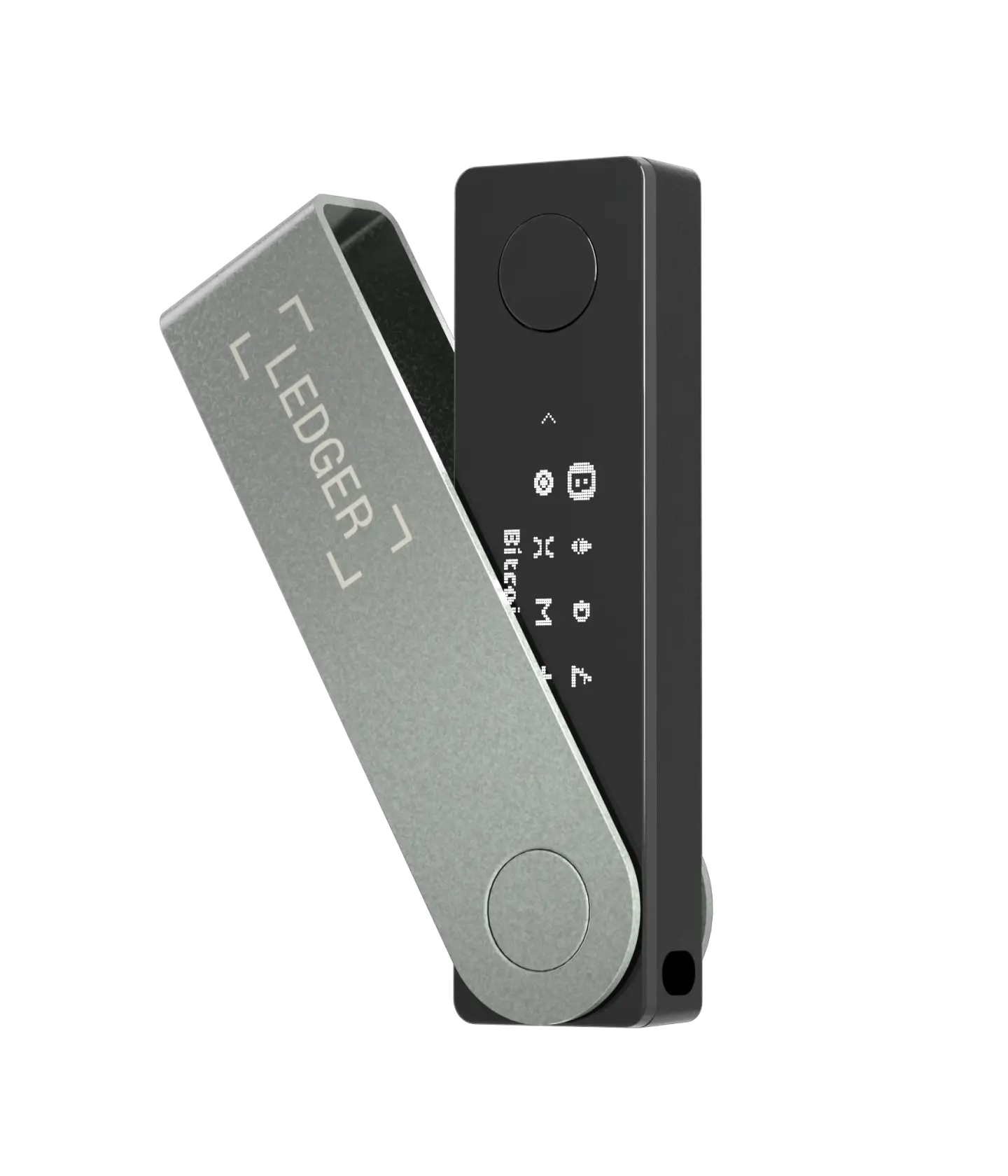
The Ledger Nano X is my #1 best multiple-coin hardware wallet because it balances portability with functionality. You can store 15,000 coins and tokens along with Ethereum NFTs, and even the wallet connects with over 50 software wallets and 100+ blcockhains.
Hence, you can use MetaMask + Ledger combo or Ledger + Exodus, whichever you find suitable. You can carry it on a keychain and pair it with your smartphone over Bluetooth or connect via USB‑C.
Today, Nano X is the most trusted wallet in the market, with over 10 million users. It uses a CC ECAL5+ secure element chip, BOLOS operating system, and PIN for the security of your cryptocurrencies. Compared to the most popular previous model, Ledger Nano S, you will get a rechargeable battery and more storage for apps.
I use it to store everything from Bitcoin and Ethereum to obscure DeFi tokens, and it handles them all. Also, it’s mobile/desktop app, the Ledger Live app, makes coin management straightforward, whether you’re staking coins or swapping altcoins on the go.
Obviously, the buttons and display are small, but after a while, you will learn to scroll addresses with patience. So, if you want a dependable daily device, Ledger remains the most secure multi-coin hardware wallet.
2. ELLIPAL Titan 2.0: Top multi-crypto cold wallet

ELLIPAL Titan 2.0 is a 100% air-gapped multi-chain hardware wallet. Means this device never touches a cable or wireless connection, and all your transactions are basically signed via QR codes displayed on its 4-inch touchscreen. For safety purposes, it also comes with a secure chip EAL5+ certified, and offers a self‑destruct feature if tampered with.
You can store over 10,000 coins and tokens across more than 40 blockchains, and the ELLIPAL app also handles NFTs on chains like Ethereum and Polygon. Plus, you can manage up to five different accounts and switch easily between them.
I think the tamper-proof design is another really nice security feature. So, if someone tries to physically force their way into the device, the wallet will automatically wipe itself, deleting all your private keys.
3. Trezor Safe 5: Anonymous and safest multi-chain hardware wallet
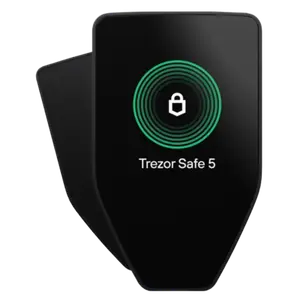
Trezor has been around since the early days, and with the Safe 5, they’ve stepped up. It is a major upgrade from previous models and now has a vibrant color touchscreen, which is a huge improvement for usability. Safe 5 even has haptic feedback, so you get a little buzz when you press a button. It just feels really nice to use. They’ve also added a Secure Element chip, CC EAL6+ certified.
It supports a wide range of cryptocurrencies, like over 9,000 coins and tokens via Trezor Suite and some popular third-party integrations. All the majors are supported, and if something isn’t directly in Trezor Suite, you can often use the Safe 5 with external wallets (for example, I use it with MetaMask for some ERC-20 tokens that Trezor’s app doesn’t list natively).
Well, the lack of any wireless connectivity could be a downside for some people. I know people prefer Bluetooth, so they can use a wallet with their phone easily; the Safe 5 isn’t built for that kind of mobile convenience. It also means the device must be plugged in while using, which slightly limits portability.
4. Ledger Flex: Best hardware wallet for multi-chain staking
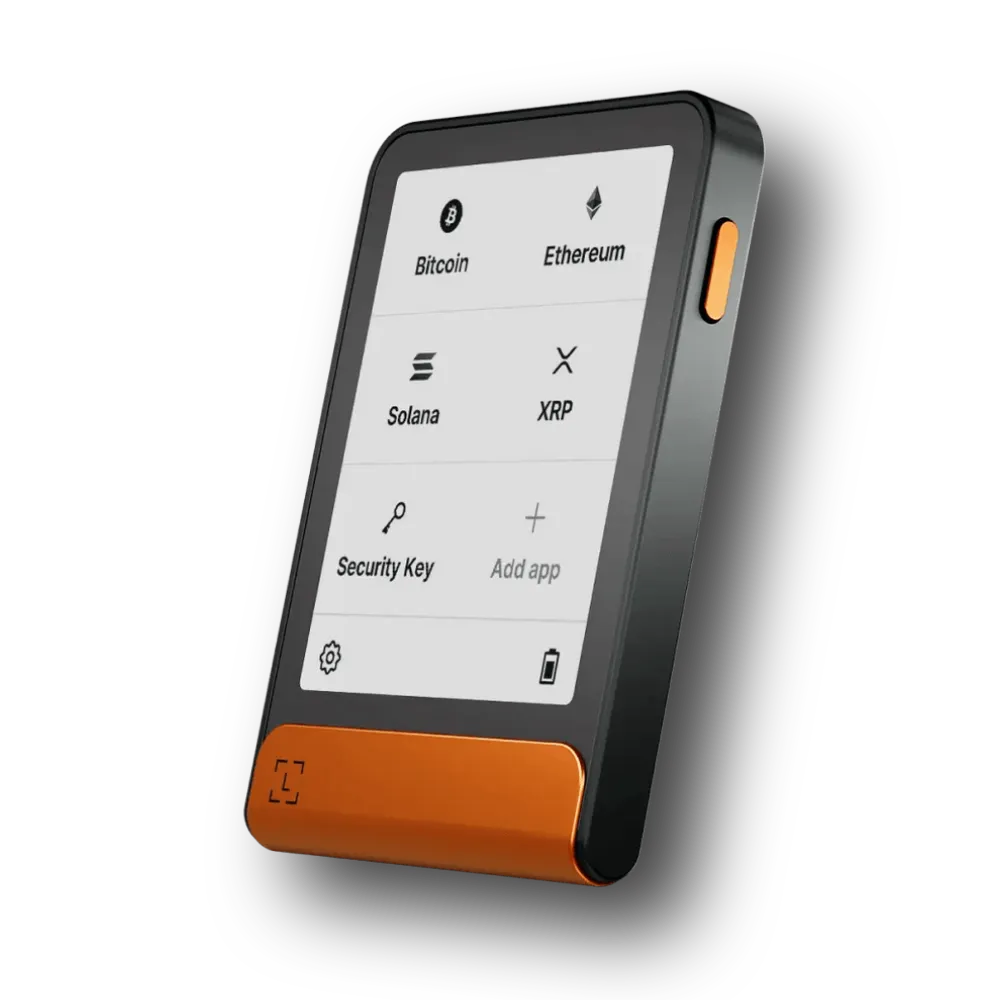
Ledger Flex is another best multi-chain hardware wallets for storing, staking, and earning rewards. Now, this one is a newer wallet from Ledger, and it’s kind of a sibling to the higher-end Ledger Stax. It’s mainly built for someone who wants the modern features of a touchscreen but still doesn’t want to pay the super-high price tag.
It supports staking by connecting with the Ledger Live app. You can earn up to 20% APY on certain assets. For staking altcoins on multiple chains, you can even connect it to popular software wallets like MetaMask, Exodus, Atomic Wallet, Coinbase Wallet, and 50+ more.
The Ledger Flex has a great E-Ink touchscreen, and it’s kind of like the screen on a Kindle e-reader. It’s really crisp and clear, and uses very little battery. The touchscreen makes it way easier to navigate than the older models that just have buttons. The Flex supports over 15,000 assets, just like the Ledger Nano X, so you know you can store all your different coins on it.
The Ledger Flex has a CC EAL6+ certified Secure Element chip, which is an even higher rating than the Nano X. It’s a seriously secure device. And, the battery lasts for weeks on a single charge, which is pretty convenient.
5. Keystone 3 Pro: Supports multiple cryptocurrencies by connecting to MetaMask

Keystone 3 Pro is another top-rated hardware wallet for multi-chain asset storage. I’ve been using a Keystone for a while, especially when interacting with decentralized apps, and it’s become one of my favorites for that purpose.
Physically, the Keystone 3 Pro is a 4-inch touchscreen device that looks like a mini smartphone as well. It’s completely air-gapped like the ELLIPAL Titan, hence you won’t find any Bluetooth, WiFi, USB port, or wireless radios. Mainly, you can transfer data by scanning QR codes or by moving a microSD card.
The Keystone 3 Pro connects to MetaMask via QR codes. Hence, you can use all the features of MetaMask (like interacting with decentralized apps and NFTs) while still keeping your private keys offline. So, you are not limited to certain coins; you can store unlimited tokens in this device.
Now, aside from the inherent slowness of QR signing, one minor issue is that the Keystone companion app (called Keystone Nexus) isn’t as feature-rich as, say, Ledger Live. Well, it’s fine for basic use and firmware updates, but for many coins, it just directs you to use third-party apps. That’s why I largely bypass it and go straight to using MetaMask or other 50+ supported apps with the Keystone.
6. ELLIPAL X Card: Most user-friendly multi-currency crypto wallet (NFC-based)

The X Card is an NFC-based tap and sign multi-chain hardware wallet. At first glance, it looks like a regular credit card or hotel key card. There’s no screen, no buttons, no battery. I was a bit skeptical: How can a card with no screen be a secure hardware wallet? But after using it, I’m actually impressed by how much they achieved with so little on the card itself.
Here, the main idea is that the X Card holds your private keys in a secure chip (EAL6+ rated secure element), and it stays completely offline. Now, to use it, you have to tap the card on your smartphone, which has the Ellipal App installed (the card uses NFC, like contactless payments).
The phone app will then prompt you to tap the card whenever you need to sign a transaction or verify ownership. The card then uses NFC to communicate the signature.
7. SafePal S1 Pro: Cheapest hardware wallet that supports most chains
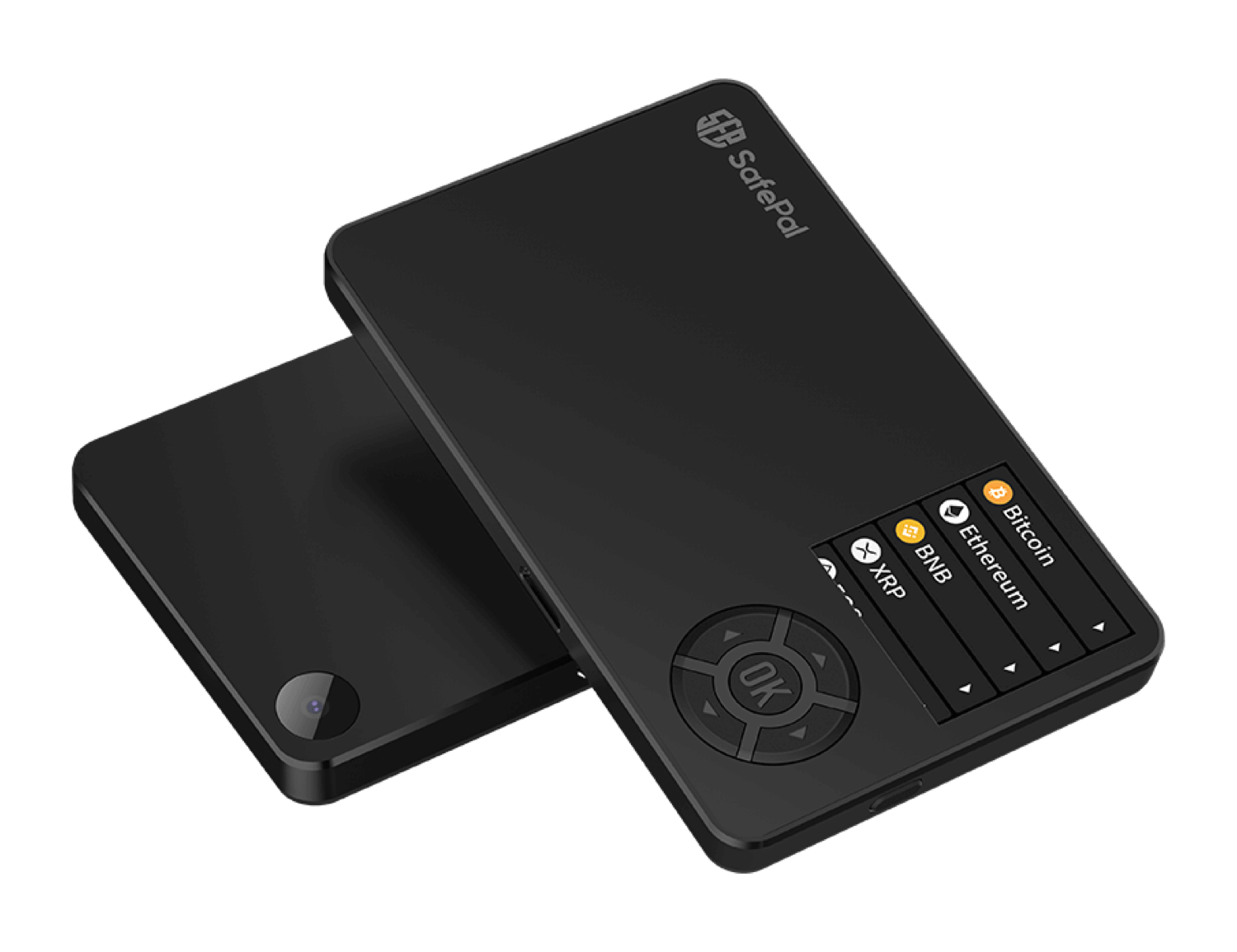
SafePal S1 Pro is one of the most affordable multi-crypto wallets out there, but it doesn’t skimp on security or functionality. It’s also an air-gapped device, so it uses QR codes to sign transactions, just like the ELLIPAL and Keystone.
I think its most promising feature is its incredible chain support. It works with a massive number of chains and tokens, like 200+ chains and over 100,000 different assets. Seriously, you can store pretty much anything on it.
For a low price, that’s almost unbelievable, and the device itself is pretty simple, with a small screen and a few buttons, but it gets the job done and works easily with the SafePal mobile app. I’ve managed NFTs, DeFi tokens, and major cryptos in an easy-to-use interface. The app even lets me swap across chains, dApp-connect, and stake.
On the security front, it’s got that EAL6+ secure element chip and a solid anti‑tampering self‑destruct mechanism.
8. NGRAVE Zero: EAL7 OS certified multi-chain cold storage wallet
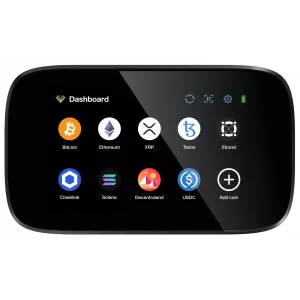
NGRAVE Zero is in my list because of its EAL7 OS. This level of certification is never found in any hardware multi-chain wallet device. But it’s highly expensive, $398 to be exact. It’s a true “zero-trust” device. It never connects to the internet and doesn’t even have an internal battery. You charge it, and then it’s ready to go.
The NGRAVE Zero also uses a completely air-gapped system with QR codes to communicate with your phone. But the nice part for me is its NGRAVE GRAPHENE backup solution. So, instead of a paper recovery phrase, it comes with a two-part metal plate. You can easily punch holes in the plates to permanently record your keys. And, it’s waterproof, fireproof, and practically indestructible.
Comparing Best Hardware Wallets for Multi-Coin Storage
You will better understand which wallet supports most chains and which is best for multi-chain crypto asset storage by putting all of these side-by-side. Here is a quick comparison between 8 best multi-chain hardware wallets:
| Wallet | Supported Coins | Supported Chains | Price (USD) | Connectivity/App |
|---|---|---|---|---|
| Ledger Nano X | 15,000+ | 100+ (BTC, ETH, SOL, etc.) | $149 | Bluetooth, USB-C / Ledger Live |
| ELLIPAL Titan 2.0 | 10,000+ | 40+ (BTC, ETH, SOL, BNB, etc.) | $129 | Air-gapped QR / ELLIPAL App |
| Trezor Safe 5 | 9,000 | 30+. | $169 | USB-C / Trezor Suite |
| Ledger Flex | 15,000 | 100+ | $249 | NFC, USB / Ledger Live |
| Keystone 3 Pro | 5,500+ | 200+ (ETH, BNB, AVAX, etc.) | $149 | QR / Keystone Nexus App |
| ELLIPAL X Card | 10,000+ | 40+ (BTC, ETH, SOL, XRP, etc.) | $99 | NFC / ELLIPAL App |
| SafePal S1 Pro | 100,000+ | 200+ chains | $69 | QR / SafePal App |
| NGRAVE Zero | 2,000+ | 20+ chains (most popular ones) | $398 | QR/Ngrave app |
What is a Multi-Chain Hardware Wallet?
A multi-chain wallet is a single wallet that can hold and manage your assets on more than one blockchain network. I guess you could say it’s a multi-cryptocurrency wallet. For example, a single wallet can hold your Bitcoin (on the Bitcoin blockchain), your Ethereum (on the Ethereum blockchain), your Solana (on the Solana blockchain), and many others as well.
Basically, it’s just a way to make your crypto storage easier. Before these multi-coin wallets existed, you would need a different wallet for each blockchain. You would have a Bitcoin wallet, an Ethereum wallet, and so on. Hence, it was a huge pain to manage all that.
Eventually, developers realized that it would be a lot more convenient to have a single wallet that could handle all these different cryptocurrencies and blockchain networks from one place. So, they created multi-chain cryptocurrency wallets.
So, it really helps with what people in the crypto world call “interoperability,” which just means making different blockchains work better together.
To learn more about how to set up and use these multi-coin hardware wallets, you can read my in-depth guide on the best crypto hardware wallets or individual hands-on reviews like Ledger Nano X review or ELLIPAL Titan 2.0 review…
Related FAQs to Know
Which hardware wallet supports the most chains?
Ledger wallets support the most chains, with over 100+ blockchain networks, including the most popular ones like Ethereum, Solana, Bitcoin, Arbitrum, Polkadot, Avalanche, Optimism, XRP, and many more.
You can also use ELLIPAL or Trezor wallet if you are looking for the best hardware wallets with most chains, because they also support around 40+ blockchains and cover most of the known mainstream networks.
Which offline wallet is best for multi-coin crypto storage?
The best offline wallet for multi-coin crypto storage is the ELLIPAL Titan 2.0, no doubt about it. It’s an air-gapped wallet, which basically means it never, ever connects to the internet with any kind of cable or wireless signal. It supports 40+ blockchains and 10,000 coins. So, you will find mostly all cryptocurrencies to store.
It only uses QR codes to communicate with your phone, and this makes it completely isolated from all online threats, such as malware and viruses. Also, this is basically the highest level of security you can get for any top multi-cryptocurrency wallet.
What is the best hardware wallet for multiple cryptos?
The best hardware wallet for multiple cryptos is honestly a tie between the Ledger Nano X and the Trezor Safe 5. Now, both of these wallets support thousands of different assets.
Well, the Ledger Nano X is a bit more user-friendly for beginners and has Bluetooth for mobile use. The Trezor Safe 5 is a favorite for people who are into open-source software and want the extra security of the new multi-share Backup system.
Obviously, you can’t really go wrong with either of them, but I guess it just depends on your personal preference. I would say buy Ledger for a better ecosystem of coins.
Is there any hardware wallet to store 100s of cryptocurrencies?
Yes, absolutely. Both the Ledger Nano X or Flex version and the Trezor Safe 5 are great options to store 100s of cryptocurrencies. To start with, they support a massive number of assets, so you can easily store all your Bitcoin, Ethereum, Solana, and your other altcoins on a single device.
The Ledger Nano X, for example, supports over 15,000 different assets. So, you can totally have a diverse portfolio and keep it all in one safe place. Even you can choose any wallet from the above list; all are top-rated for security and storing multiple digital assets.
What are the top multi-chain crypto wallets to consider today?
Today, you should consider the Ledger Nano X, ELLIPAL Titan 2.0, Trezor Safe 5, Ledger Flex, Keystone 3 Pro, and ELLIPAL X Card as your best multi-coin crypto hardware wallets.
All six of these devices represent the very best options available for storing multiple cryptocurrencies securely, and they each offer unique features, like air-gapped security, touchscreen interfaces, Bluetooth connectivity, or even NFC-based transactions.
Basically, they all have a solid reputation and are trusted by millions of people in the crypto community. Now, if you want a software wallet for storing a bulk of coins, MetaMask, Trust Wallet, and Phantom are recommended.
What are the most promising cross-chain wallets right now?
The most promising cross-chain wallets right now are the ones that work easily with multiple blockchains and integrate with different software wallets and dApps. So, I would say the Ledger Flex and the Keystone 3 Pro are at the top of my list.
The Ledger Flex is promising because of its good staking features and user-friendly touchscreen, whereas the Keystone 3 Pro is promising because its air-gapped design combined with perfect MetaMask integration. Keystone even supports Shamir backup.
